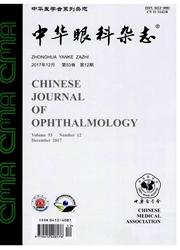

 中文摘要:
中文摘要:
目的:探讨飞秒激光小切口角膜基质透镜取出术(SMILE)前后角膜生物力学参数的变化及组织去除厚度、组织去除厚度百分比(PTA)对角膜生物力学的影响,并寻求组织去除厚度的相对安全范围。方法临床观察研究。入选2014年9月至2015年7月在天津市眼科医院行SMILE的屈光不正患者共187例(365只眼),于术前、术后使用眼反应仪(ORA)测量角膜滞后量(CH)和角膜阻力因子(CRF)。对术前CH、CRF与角膜中央厚度(CCT)进行线性回归分析;对变化量ΔCH、ΔCRF与角膜组织去除厚度、PTA进行非线性回归分析,以最佳拟合曲线五阶多项式函数进行计算和分析。结果CH、CRF术后较术前分别减少20.7%、33.0%,差异具有统计学意义(t=24.970,P=0.000;t=35.452,P=0.000)。术前CH、CRF与CCT呈正相关(r=0.483,P=0.000;r=0.507,P=0.000)。对ΔCH、ΔCRF与组织去除厚度(30~160μm)进行非线性回归分析发现:随着组织去除厚度增加,ΔCH、ΔCRF增加。当组织去除厚度小于50μm时,ΔCH、ΔCRF变化率较大;当去除厚度为50~140μm时,ΔCH、ΔCRF变化率较小;当去除厚度超过140μm时,ΔCH、ΔCRF变化率较大,ΔCH、ΔCRF增加明显,PTA变化趋势同组织去除厚度相似。结论正常角膜厚度对角膜生物力学特性有一定影响,SMILE术后角膜生物力学特性发生一些变化,CCT越薄,组织去除厚度越大,术后生物力学下降越明显;组织去除厚度在不超过140μm、PTA不超过25%时相对安全。(中华眼科杂志,2017,53:11-17)
 英文摘要:
英文摘要:
Objective To investigate biomechanical effects of central corneal thickness (CCT), and to explore the possible safe range for the tissue removal and percentage of tissue ablation (PTA) of small incision lenticule extraction (SMILE). Methods Clinical observational study. One hundred and eighty-seven cases (365 eyes) undergoing SMILE surgery were enrolled. Corneal hysteresis (CH) and corneal resistance factor (CRF) were measured before and after surgery by the ocular response analyzer (ORA). Linear regression of CH, CRF and CCT, and percentage of tissue ablation were calculated. The fifth order polynomial functions provided the closest fit to the data of ΔCH, ΔCRF and the thickness of tissue removal. Results CH and CRF decreased by 20.7%and 33.0%, respectively, after SMILE, and statistically significant differences were found between preoperative and postoperative values (P〈0.05). CH and CRF showed a positive correlation to CCT (r=0.483, P〈0.05. r=0.507, P〈0.05). The fifth order polynomial functions showed that ΔCH and ΔCRF increased with the increasing tissue removal. The variety rate ofΔCH andΔCRF was lower after 50μm to 140μm of tissue removal, but was higher when the tissue removal was less than 50 μm and more than 140 μm. The variation trend was similar for PTA. Conclusions Corneal thickness has an effect on the corneal biomechanical properties, which decrease with the increase of tissue removal. It seems that the tissue removal of less than 140μm and the PTA of less than 25%are safer in SMILE, and further investigations are needed.
 同期刊论文项目
同期刊论文项目
 同项目期刊论文
同项目期刊论文
 期刊信息
期刊信息
